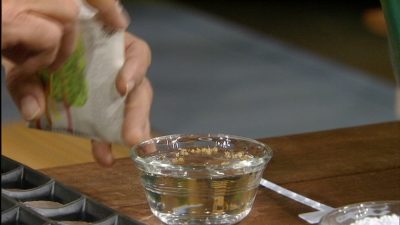Success with Seeds

by Trisha Shirey
Planting from seeds is easy and economical, and there are many things that can be planted directly in the soil for the fall garden. Tomatoes, peppers and eggplant for the spring garden are generally started by transplanting because of their long growing season and cold tenderness. Carrots, beets, radishes and many other crops are most often planted directly in the soil. Seeds can be finicky and there are many things that can lead to crop failure.
To ensure success with direct seeding remember these tips:
Plant in moist soil. I like to prepare the planting area by adding compost and fertilizer and water it well. I plant seeds 24 to 48 hours later. Too much compost or fertilizer can digest seed before it germinates.
Plant at the proper depth. For most seeds, this means planting twice as deep as the seed’s width. Very fine seeds like poppies or carrots are often planted on the soil surface and pressed in, not covered, or are covered with a light layer of fine soil. Planting too deeply causes seeds to fail as they do not have adequate food resources to grow long stems to reach the soil surface.
Water seeds gently. Use a water breaker nozzle or a fine mist spray so seeds are not washed away. Most seeds need consistent moisture after germination to continue growing. A few hours of being dry could result in crop failure.
Cover seeds as needed to protect them. Bean, corn, peas and other seeds are very attractive to birds and they will often clear out large areas of newly planted or sprouted plantings. They don’t leave much evidence so a gardener may not know why several feet of their bean row does not appear. Cover the seed beds with light weight row cover to prevent bird damage and to shade the soil to keep it from drying out. Use boards or rocks to hold the edges down over the soil. The fabric blocks about 15 percent of sunlight but allows water to go through easily.
Presoak seeds several hours or overnight to increase germination. Large seeds like beans and peas should not be soaked more than two to four hours. Spinach, chard and beets can benefit from overnight soaking to soften the seed coat. Soaking longer than 24 hours can lead to stagnant water and the loss of oxygen in the water can kill the seeds. Allow seeds to dry briefly on newsprint or paper towels to make them easier to handle for planting.
Label what you are planting with the date. I usually include the brand of seed also. Use the back of last season’s plastic plant labels or Popsicle sticks. I recycle metal mini blinds by cutting them into long lasting 12 inch tall plant labels. Notch the ends to make it easier to insert them in the soil.
Save your seed packets to remind you of the proper thinning spacing. Often the packets with have a drawing included to help you identify the seedlings. I jot down a few notes in my planting journal so I remember what I planted and when from year to year.
Thin plants when they have their second set of true leaves. I use a pair of scissors to cut the thinning to the ground so that I do not disturb the roots of adjacent seedlings. Failure to thin plants as directed leads to crowding of roots and stressed plants. It is better to have 3 healthy plants in a row than 12 struggling ones! Many of the thinned seedlings can be enjoyed in salads or stir fries so they are not wasted.
If you must thin and move plants, hold the plants by the leaves, not the stem. The plant can grow another leaf if it gets damaged but dies if the stem goes. Use a kitchen fork to gently pry them from the soil and plant immediately in the new spot. Shade delicate transplants for a few days after planting.
Pay attention to the dates on the seed package. Larger seeds like beans will maintain viability better than fine seeds like lettuce. If seeds are old, plant more than you normally would to ensure an adequate planting.
Store your unused seeds in a cool, dry place. The garden shed or garage is not a good location for seed viability. Close seed up in glass jars. I put the seeds I am going to plant in a plastic bag to take to the garden to protect them in case I spill water or overspray with a hose.
Other reasons seeds may not germinate include the soil temperature being too hot or cold for the variety. Pay attention to recommended planting times for your area. Fertilizer can burn new seedlings and insects and worms can eat new seedlings also. Despite all the challenges, seeds will grow. So don’t give up! And if we don’t succeed this season, at least we will have learned from our mistakes!
categories:
tags:
related:

 Trisha Shirey
Trisha Shirey